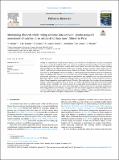Files in this item
Minimising discards while taking revenue into account : spatio-temporal assessment of catches in an artisanal shrimp trawl fishery in Peru
Item metadata
| dc.contributor.author | Mendo, Tania | |
| dc.contributor.author | Ransijn, Janneke | |
| dc.contributor.author | Gomez, I. | |
| dc.contributor.author | Gozzer-Wuest, R. | |
| dc.contributor.author | Paradinas, I. | |
| dc.contributor.author | James, Mark Andrew | |
| dc.contributor.author | Mendo, J. | |
| dc.date.accessioned | 2023-01-25T13:30:05Z | |
| dc.date.available | 2023-01-25T13:30:05Z | |
| dc.date.issued | 2023-05-01 | |
| dc.identifier | 283069023 | |
| dc.identifier | d7c7d9cb-ab8a-4f1e-a6f6-1c8aaaf49093 | |
| dc.identifier | 85146951823 | |
| dc.identifier.citation | Mendo , T , Ransijn , J , Gomez , I , Gozzer-Wuest , R , Paradinas , I , James , M A & Mendo , J 2023 , ' Minimising discards while taking revenue into account : spatio-temporal assessment of catches in an artisanal shrimp trawl fishery in Peru ' , Fisheries Research , vol. 261 , 106623 . https://doi.org/10.1016/j.fishres.2023.106623 | en |
| dc.identifier.issn | 0165-7836 | |
| dc.identifier.other | ORCID: /0000-0002-7182-1725/work/127573479 | |
| dc.identifier.other | ORCID: /0000-0002-2245-7947/work/127574015 | |
| dc.identifier.other | ORCID: /0000-0003-4397-2064/work/148888367 | |
| dc.identifier.uri | https://hdl.handle.net/10023/26831 | |
| dc.description | Funding: Newton Fund (414695818); University of St Andrews Impact and Innovation 2021; Fondo Nacional de Desarrollo Científico Tecno 2018-222. | en |
| dc.description.abstract | Around 4.2 million tonnes of fish and other species, some of which are of conservation concern, are discarded every year in bottom trawl fisheries. This study focusses on a small-scale shrimp trawl fishery located in northern Peru that operates with high level of discards which causes conflict with other local fishers. Despite trawling being an illegal activity within the 5NM off the coast, this fishery has been operating in these inshore areas for over 40 years because it sustains the well-being of hundreds of fishers. This study aimed to identify the factors that affect the spatio-temporal variation in catches in order to propose recommendations that can be adopted by fishers to minimise their impact on the ecosystem while still providing economic opportunities. The spatial distributions of shrimp, main commercial species and discards were modelled over time using hierarchical generalised additive models. Strong spatio-temporal variation was observed for all catch components and moon phase affected commercial species and discards differently. The results show that, to reduce the environmental impacts of this fishery in the short-term, the fishing area could be divided into north and south and that fishing activities should be limited to the southern area in the autumn. Other recommendations rely on temporal closures during the week of the first quarter of the moon phase. Finally, considering the institutional weaknesses in monitoring, control and surveillance, we suggest that the only realistic approach to reduce the fishery's environmental impacts in the short-term is to foster the willingness of fishers to adopt responsible fishing practices. Yet, long-term solutions will require comprehensive co-management efforts. | |
| dc.format.extent | 7 | |
| dc.format.extent | 2042566 | |
| dc.language.iso | eng | |
| dc.relation.ispartof | Fisheries Research | en |
| dc.subject | Generalised Additive model | en |
| dc.subject | Bycatch | en |
| dc.subject | Small-scale fisheries | en |
| dc.subject | IUU | en |
| dc.subject | SH Aquaculture. Fisheries. Angling | en |
| dc.subject | E-DAS | en |
| dc.subject | SDG 14 - Life Below Water | en |
| dc.subject | MCC | en |
| dc.subject.lcc | SH | en |
| dc.title | Minimising discards while taking revenue into account : spatio-temporal assessment of catches in an artisanal shrimp trawl fishery in Peru | en |
| dc.type | Journal article | en |
| dc.contributor.institution | University of St Andrews. Coastal Resources Management Group | en |
| dc.contributor.institution | University of St Andrews. School of Biology | en |
| dc.contributor.institution | University of St Andrews. Scottish Oceans Institute | en |
| dc.contributor.institution | University of St Andrews. Sea Mammal Research Unit | en |
| dc.contributor.institution | University of St Andrews. Marine Alliance for Science & Technology Scotland | en |
| dc.contributor.institution | University of St Andrews. Institute of Behavioural and Neural Sciences | en |
| dc.identifier.doi | https://doi.org/10.1016/j.fishres.2023.106623 | |
| dc.description.status | Peer reviewed | en |
This item appears in the following Collection(s)
Items in the St Andrews Research Repository are protected by copyright, with all rights reserved, unless otherwise indicated.

